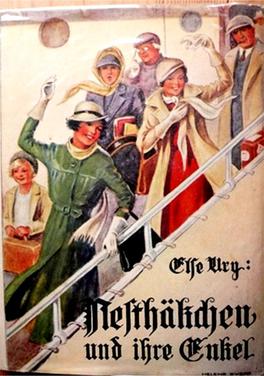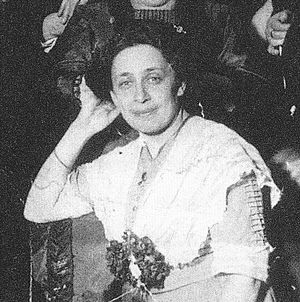Nesthäkchen and Her Grandchildren facts for kids
 |
|
| Author | Else Ury |
|---|---|
| Original title | Nesthäkchen und Ihre Enkel |
| Illustrator | Robert Sedlacek |
| Country | Germany |
| Language | German |
| Series | Nesthäkchen, volume 9 |
| Genre | Fiction/Adventure |
| Publisher | Meidingers Jugendschriften Verlag |
|
Publication date
|
1924 |
| Media type | Print (Hardcover) |
| Pages | 191 pp (Hardcover edition) |
| Preceded by | Nesthäkchen's Youngest |
| Followed by | Nesthäkchen With White Hair |
Nesthäkchen and Her Grandchildren is the ninth book in the popular Nesthäkchen series by Else Ury. The series tells the story of Annemarie Braun, a doctor's daughter from Berlin, from when she was a baby all the way to her old age. This book, published in 1924, focuses on Annemarie's life as her youngest child, Ursel, returns to Germany. Ursel comes back with her husband and children after living in Brazil for 16 years.
What Happens in the Story?
The year is 1961. Sixteen years have passed since Ursel got married. She has not seen her family in Germany during all this time. Ursel lives in São Paulo, Brazil, with her husband, Milton Tavares. They have two very different fourteen-year-old twin daughters, Anita and Marietta, and a small son, Juan.
The Tavares family is very wealthy and lives a fancy life. However, Ursel works hard to help the plantation workers who are not treated fairly. Marietta wants to be like her kind mother. Her spoiled twin sister, Anita, only thinks about herself.
One day, Marietta gets lost on a nearby plantation. She finds a little German girl named Lotte Müller. Lotte's mother is very sick and dying in a small hut. The Tavares family adopts Lotte, who is now an orphan. They decide to take her with them on their planned trip to Germany. They hope to find Lotte's relatives there.
Meanwhile, Annemarie in Germany misses her youngest daughter, Ursel, very much. She has become a beloved "Omama" (grandma) to her other grandchildren. These include Gerda, Lilli, Eva, Ned, and Heinz.
When Anita and Marietta arrive in Germany, they face some challenges. The two rich girls find it hard to get used to a simpler life. They do not want to help Rudolf and Annemarie with the housework. But the modest Marietta soon adjusts. She starts to become more independent from her bossy twin sister.
Little Lotte lives in the Hartenstein house with the servant couple, the Kunzes. She becomes like a daughter to them. Her relatives, who were originally from Silesia and later from Westphalia, cannot be found.
A dramatic event happens when Rudolf has a heart attack. He is afraid he might die without seeing Ursel again. Marietta secretly sends a telegram to her mother. She tells Ursel about her father's illness. One day, Ursel arrives unexpectedly with little Juan. Her husband, Milton, arrives soon after.
In the end, fifteen-year-old Marietta decides to stay in Germany. She chooses to live with Rudolf and Annemarie.
About the Book's Style
The Nesthäkchen books belong to a German type of literature called the Backfischroman. This means "girls' novel." These books describe a girl growing up and were written for readers aged 12 to 16. A "Backfisch" was a term for a young girl between fourteen and seventeen years old.
The Backfischroman style was popular from 1850 to 1950. These stories often showed common ideas about how girls should grow up. They usually ended with the heroine getting married and becoming a Hausfrau (housewife).
Besides Else Ury, other famous Backfischroman authors included Magda Trott and Emmy von Rhoden. Emmy von Rhoden wrote the book Der Trotzkopf. Henny Koch was another well-known author.
Else Ury originally planned to end the Nesthäkchen series with volume 6, Nesthäkchen Flies From the Nest. This book described Nesthäkchen's marriage. However, her publisher in Berlin received many letters from young fans. They begged for more Nesthäkchen stories. After some thought, Ury wrote four more books. She even mentioned her doubts about continuing the series in the seventh book, Nesthäkchen and Her Chicks.
About the Author, Else Ury
Else Ury was a German writer. She was born on November 1, 1877, in Berlin. Sadly, she died on January 13, 1943, in the Auschwitz concentration camp.
Her most famous character is Annemarie Braun, the blonde doctor's daughter. Annemarie's life, from childhood to old age, is told in the ten very successful Nesthäkchen books. These books, along with a six-part TV series from 1983, have been enjoyed by millions of readers and viewers. A new DVD edition of the TV series was released in 2005.


